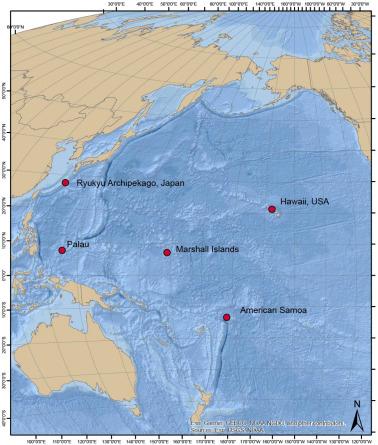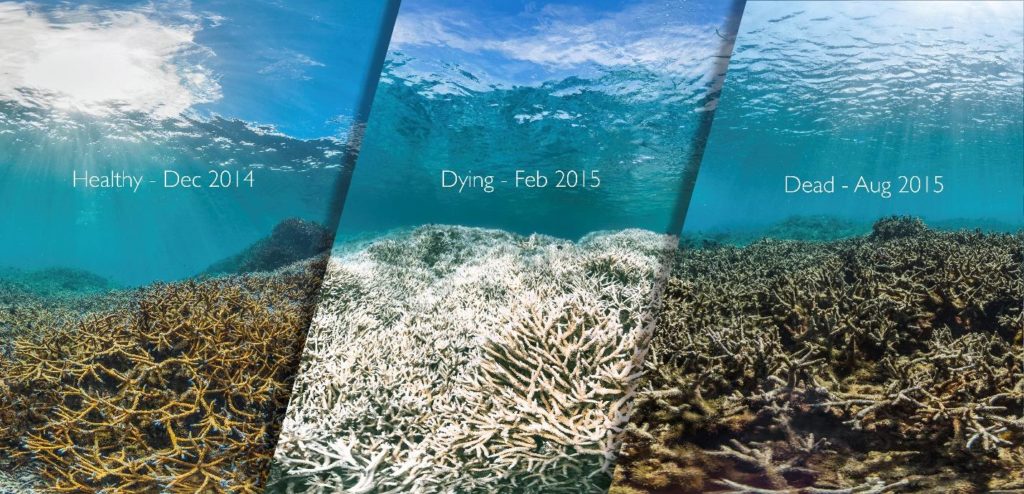Ocean acidification occurs when the pH level of seawater decreases. This is most frequently caused by the ocean absorbing excess CO2 from the atmosphere. By evaluating an ocean acidification case study, we can get a sense of how damaging ocean acidification currently is, and what measures can be implemented to prevent further damage.
This article will outline a case study on how ocean acidification affects coral reefs in the Pacific Basin, as well as proposed solutions to prevent further damage.
Background Information: Ocean Acidification Infographic
About the Case Study
This study, Lebrec et al. 2019, was originally published in the journal “Regional Studies in Marine Science.” It discusses the effects of ocean acidification on coral reefs in the Pacific Basin, where mass coral bleaching has occurred. The case study highlights five coral reef ecosystems in the Pacific basin, which are found in the following locations:
- Ryukyu Archipelago, Japan
- Palau
- Hawaii
- Marshall Islands
- American Samoa

Source: Lebrec et al. 2019
The case study evaluates the impact of ocean acidification on the above locations and proposes solutions to prevent ocean acidification and other ocean stressors from causing further damage to coral reefs.
Source: Ocean acidification impacts in select Pacific Basin coral reef ecosystems
Main Takeaways
Here are the main takeaways from the case study:
- Ocean acidification negatively affects the coral reefs in the Pacific Basin by reducing the amount of calcium carbonate that is essential to coral reef skeletal development and coral survival. This causes coral reef death.
- The study highlights the importance of unique coral diversity in each of the five geographic locations, as well as the vital role coral reefs play in local communities and economies.
- Hawaiian coral reefs are not just important to the tourism industry, but they also provide direct benefits to the community by sustaining fisheries and pharmaceutical production, which generate income through exportations. Hawaiian coral reefs also provide indirect benefits to the community by protecting coastal areas from storms. The economic value of coral reefs in Hawaii is about $455 million USD.
- The Marshall Islands is the world’s most coral reef-dependent country. Most of their needs are met by the reef, including employment, nutrition, exportation, tourism, and protection against natural disasters.
- The Ryukyu Archipelago is home to more than 360 species of corals, which makes it the world’s richest endemic coral reef. The archipelago’s coral reef plays an important role in its economy, generating $4.7 billion USD tourism revenue in a single year.
- Palau is home to around 425 species of coral reef, which makes the country the most biodiverse coral reef in all of Micronesia. It provides 40% of the country’s employment, as over 90% of tourists that visit the island come for diving and snorkeling.
- American Samoa is home to about 200 coral reef species, which is why the government established 6 major protected areas for coral reefs across the archipelago.
- The locations in the case study are experiencing coral bleaching events due to the combined effects of different disasters, pollution, and ocean acidification. This affects these countries since all of them rely heavily on the services that coral reefs provide.
- Hawaiian coral reefs are bleaching as a result of rising temperatures and ocean acidification, and certain coral reef species are recovering at a slower rate than expected.
- Increasing temperatures have bleached over 90% of the coral reefs of Okinawa Island, which is part of the Ryukyu archipelago.
- From 1997 to 1998, Palau had a GDP decline of about 3.3% due to intense coral bleaching events.

Source: Coral Reef Watch/NOAA
Proposed Solutions to Fight Ocean Acidification-Related Bleaching
This case study provides 3 proposed solutions to fight ocean acidification and its damage to the coral reefs in the Pacific basin.
- Adaptation promotes the resilience of coral reefs by initiating conservation regulations and the reforestation of coral reefs, and increasing coral reef protected areas.
- Mitigation covers the reduction of carbon emissions at the global and local scales. This could be in the form of carbon taxation, an emissions trading system, or a cap-and-trade system.
- Capacity Building focuses on promoting local research advancements and spreading education and awareness to the community, generating funds to improve coral reef conservation efforts, and creating local collaborative efforts to promote national policies that push for unified international policies.
Conclusions
This case study highlights the importance of coral reefs in the Pacific Basin and how the countries around it majorly depend on the services that the coral reefs provide. Understanding the impacts of ocean acidification on coral reefs in the Pacific basin can help us promote solutions to ensure their benefits to humans and ecosystems remain intact.
This case study is just a part of a much larger global issue of ocean acidification and its negative effects. There are many other countries around the world that are experiencing not only coral reef bleaching but also damage to marine animals and microorganisms that are essential to maintaining the ecological balance of the world. The case study emphasizes the importance of addressing ocean acidification, as if we fail, people all over the world will lose sources of food, income, and culture.